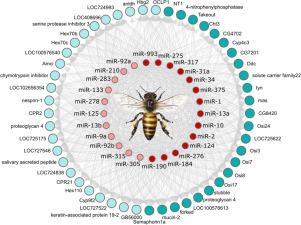Biochimica et Biophysica Acta (BBA) - Gene Regulatory Mechanisms ( IF 4.7 ) Pub Date : 2021-07-07 , DOI: 10.1016/j.bbagrm.2021.194732 Joseana Vieira 1 , Flávia Cristina de Paula Freitas 2 , Alexandre Santos Cristino 3 , Daniel Guariz Pinheiro 4 , Luiz Roberto Aguiar 5 , Marcela Aparecida Framartino Bezerra Laure 5 , Lívia Maria Rosatto Moda 1 , Zilá Luz Paulino Simões 6 , Angel Roberto Barchuk 1

|
Brain differential morphogenesis in females is one of the major phenotypic manifestations of caste development in honey bees. Brain diphenism appears at the fourth larval phase as a result of the differential feeding regime developing females are submitted during early phases of larval development. Here, we used a forward genetics approach to test the early brain molecular response to differential feeding leading to the brain diphenism observed at later developmental phases. Using RNA sequencing analysis, we identified 53 differentially expressed genes (DEGs) between the brains of queens and workers at the third larval phase. Since miRNAs have been suggested to play a role in caste differentiation after horizontal and vertical transmission, we tested their potential participation in regulating the DEGs. The miRNA-mRNA interaction network, including the DEGs and the royal- and worker-jelly enriched miRNA populations, revealed a subset of miRNAs potentially involved in regulating the expression of DEGs. The interaction of miR-34, miR-210, and miR-317 with Takeout, Neurotrophin-1, Forked, and Masquerade genes was experimentally confirmed using a luciferase reporter system. Taken together, our results reconstruct the regulatory network that governs the development of the early brain diphenism in honey bees.
中文翻译:

蜜蜂Apis mellifera对差异喂养的早期大脑发育反应的分子基础
雌性的大脑差异形态发生是蜜蜂种姓发育的主要表型表现之一。由于发育中的雌性在幼虫发育的早期阶段接受不同的喂养方式,因此在第四个幼虫阶段会出现脑diphenism 。在这里,我们使用前向遗传学方法来测试早期大脑分子对差异喂养的反应,导致在后期发育阶段观察到的大脑二苯。使用RNA 测序通过分析,我们在第三幼虫期的蚁后和工蚁大脑之间鉴定了 53 个差异表达基因 (DEG)。由于 miRNA 被认为在水平和垂直传播后的种姓分化中发挥作用,我们测试了它们在调节 DEG 方面的潜在参与。miRNA-mRNA 相互作用网络,包括 DEG 和富含蜂王浆和工蜂的 miRNA 种群,揭示了可能参与调节 DEG 表达的 miRNA 子集。miR-34、miR-210 和 miR-317 与Takeout、Neurotrophin-1、Forked和Masquerade的相互作用使用荧光素酶报告系统通过实验证实了 基因。综上所述,我们的结果重建了控制蜜蜂早期脑二苯醚发育的调节网络。


























 京公网安备 11010802027423号
京公网安备 11010802027423号